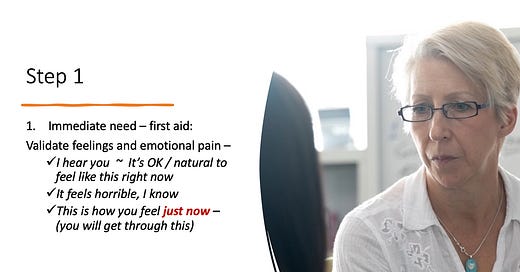For my second contribution to Children’s Mental Health Week (the first was here) I am offering you my cunning 3-step resilience treatment.
Who is this for?
Anyone of any age - you just adapt the wording to suit the age and understanding of the person.
You can apply the treatment to yourself and you can do it for someone else - your child/teenager, partner, friend, colleague.
Anyone who is dealing with a situation where they feel, rightly or wrongly, that they have done badly - a “failure” or setback. It could be doing badly in a test, failing an audition or interview, messing up a presentation or performance, embarrassing themselves in public.
For clarity, this is not to address something like an accident, illness or bereavement. It’s for a situation where the person feels they underperformed or did badly or made a mistake or where they wish they’d acted or reacted differently. For whatever reason, it went badly and they are suffering distress.
The analogy
For this I want you to think about a physical injury. Let’s say, for the sake of argument, someone has fallen and broken their arm.
There would be three stages to dealing with this:
Immediate need - first aid. You’d support the broken limb, deal with pain and shock.
Main treatment. Then, when appropriate, medics would set the bone and apply a plaster cast. Then the healing can happen.
Rebuild strength. Once the bone was set and the treatment was successful, you’d have physio to rebuild strength.
How to apply this to a mental upset
1. Immediate need - supporting and dealing with (mental) pain
This is done with words, empathy and just being there and acknowledging the emotional reactions to whatever has happened.
If it’s genuinely something you’ve experienced yourself, you can say so - but be careful not to make it about you. Almost everyone has experienced failure or embarrassment or disappointment, so relating this experience to the commonality of human experience helps them feel less alone and less of a “failure”.
Don’t expect to be able to “fix” their feelings simply with words but what you’re trying to do is a) show them that you empathise b) show them that what they are feeling is completely natural and understandable and c) that this feeling is temporary. “This is how you feel just now.”
What if you think they are over-reacting to the situation? Be cautious here. Saying “don’t be silly” is not the answer but perhaps “Honestly, mate, this is not as bad as you feel it is right now” could be OK. Just be careful not to dismiss their feelings.
This stage can take minutes, hours or a day or two. Ideally not longer. And you can start Step 2 even before Step 1 is finished.
2. The main treatment
This is where you can really get to work on turning this “disaster” around. Get the person to think honestly about why it happened. Include both things that were in their control and things that weren’t.
For example, they could have done a poor performance for any or a combination of these reasons:
Not practising enough - break this down into why: Laziness? Fear? Too busy? Poor foresight? Poor planning? Over-confidence? Distraction? Social media over-use?
Practising ineffectively - putting in the time but not doing the right things.
A bad night’s sleep - and was there anything they could have done to change that?
Headache / cold / period pains etc
Panic / nerves / freezing
Something put them off?
Any other things, big or small
Then you help them see whether any of those things could be done differently next time. How will they make that happen? Do they need help from anyone else? How will they get that?
Crucially, what could they do now, rather than waiting for the next time. Doing something now is a great way to start getting back on track.
Step 2 takes however long it needs to take. And it can carry on even after you’ve started Step 3, which you can do as soon as you’ve got to grips with Step 2.
3. Rebuilding (mental) strength
This is about generally having as many healthy aspects to your life as possible. It’s an ongoing process - it never ends! The more of this you do, the more resilient you will be. Storms will still come your way but they will be less likely to make you feel unable to cope.
Both No Worries and Positively Teenage focus on the skills you need for this mental physiotherapy stage.
I use my Table of Wellbeing model, with its four equally-important legs: food+water, exercise, sleep and relaxation. There are many, many ways of building each of these. Different people may have different weaknesses in their “legs” and therefore need to focus more on one than the others, but they all must be kept as strong as possible.
In short
The 3-step approach to distress works really well for all ages. By breaking the problem down into steps and giving practical actions, you give agency to the person (or yourself) and the feeling that “Yes, this feels rubbish right now but there are things that will turn the problem into round, something that went badly but which I can learn from.”
Turning failure into future success. Being strong. Being mentally healthy and ready for the ups and downs of life. Repairing that boat so that it can not only sail across a stormy ocean but also enjoy the calm days and the exciting opportunities.






